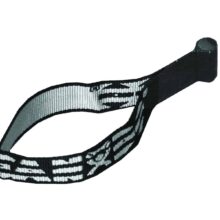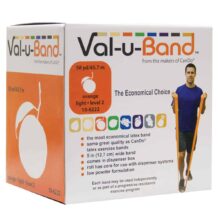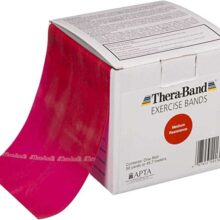Adjustable Exercise Band
Login For Dealer Pricing
The resistance of each band can be increased or decreased by adjusting length of band used. The band is 8″ in length and 1″ in width. Available in extra light to extra heavy resistance levels.
Resistance bands are a portable and versatile exercise option that will allow you to keep fit while you are on the road or social distancing at home. The advantages offered by these bands also include lower risk of injury, improved flexibility and increased range of motion.
Resistance bands have gained popularity as a valuable tool in sports medicine due to their versatility, convenience, and effectiveness in improving athletic performance, preventing injuries, and aiding in rehabilitation.
These elastic bands provide resistance throughout a range of motion, allowing athletes to strengthen specific muscle groups, enhance flexibility, and improve overall functional movements.
In the next few paragraphs of this article, we will explore the diverse role of resistance bands in sports medicine and highlight their numerous benefits for athletes.
Resistance bands offer an effective means of strengthening muscles, enhancing power, and improving athletic performance. Athletes can target specific muscle groups by performing a wide range of resistance band exercises. The bands provide variable resistance, meaning the tension increases as the band is stretched, allowing for progressive overload and muscle adaptation. This targeted strength training helps athletes develop muscular strength, power, and explosiveness, which are essential for sports requiring speed, agility, and force production.
In sports medicine, resistance bands are widely utilized in injury prevention programs. By targeting specific muscle groups, resistance band exercises help athletes correct muscle imbalances, improve joint stability, and enhance neuromuscular control. These exercises engage the smaller stabilizing muscles, tendons, and ligaments, reducing the risk of common sports-related injuries, such as strains, sprains, and overuse injuries. Resistance bands can assist in strengthening key areas prone to injury, such as the hips, shoulders, and ankles, promoting overall musculoskeletal health.
Resistance bands are a valuable tool for rehabilitation and physical therapy following sports injuries or surgeries. They provide a controlled and safe way to gradually reintroduce movement and strength to the injured area. With resistance band exercises, athletes can target specific muscles or joints to rebuild strength, improve flexibility, and restore range of motion. Resistance bands also offer low-impact resistance, making them suitable for individuals with joint issues or those in the early stages of rehabilitation.
Flexibility and mobility are essential components of athletic performance. Resistance bands can be used to improve joint flexibility and increase the range of motion in specific muscle groups. Athletes can perform stretching exercises with the bands to enhance flexibility, release tight muscles, and prevent muscle imbalances. The controlled resistance provided by the bands allows for a gradual and progressive stretching process, promoting safer and more effective gains in flexibility and joint mobility.
A strong core and good balance are crucial for athletes in various sports. Resistance bands can be incorporated into exercises that target the core muscles, including the abdominal and back muscles. These exercises engage the core to stabilize the body during dynamic movements, improving balance, stability, and coordination. The bands challenge the core muscles to work in concert with other muscle groups, replicating the demands placed on the body during athletic activities.
One of the notable advantages of resistance bands is their portability and convenience. They are lightweight, compact, and easy to transport, allowing athletes to incorporate resistance band exercises into their training routines, both at home and on the go. Whether training in a gym, on the field, or while traveling, athletes can use resistance bands to maintain strength, flexibility, and injury prevention efforts. This accessibility ensures consistent training and helps athletes stay on track with their fitness and rehabilitation goals.
In contrast with free weights, resistance bands don’t depend on the force of gravity to be effective. As a result, there is less risk of joint compression and the resultant joint injuries.
Many resistance band exercises incorporate stretching movements. As a result, by exercising with these bands, you warm up your muscles by performing repeated and active muscle contractions against resistance together with a dynamic lengthening of your muscles.
Resistance bands also allow you to combine flexibility improvement with strength training. You an use the elastic nature of the band to let your body go through the full eccentric phase of each rep, with your joints and muscles 100% mobilized and stretched. In addition, you can vary the planes of motion to exploit angles that you simply cannot reach by doing body weight or free weight strength training.
A third aspect of the flexibility improvement that is available through using resistance bands is the ability to intersperse low intensity, high rep training sessions with more aggressive training sessions. These low resistance, high rep sessions will allow the soft tissues to be lengthened and challenged without the creation of inflammation that would lead to muscle pain and joint stiffness. Instead, the low intensity, high rep sessions improve blood circulation and provide fatigued tissues with freshly oxygenated blood, thus shortening the time needed to recover.
Resistance bands have revolutionized sports medicine by providing athletes with a versatile and effective tool for strength training, injury prevention, rehabilitation, and performance enhancement. By targeting specific muscle groups, improving flexibility, promoting core stability, and offering portability, resistance bands have become a valuable asset in the pursuit of optimal athletic performance and overall well-being. Incorporating resistance band exercises into sports medicine protocols allows athletes to train smarter, prevent injury and enhance sports performance.

Login For Dealer Pricing
The resistance of each band can be increased or decreased by adjusting length of band used. The band is 8″ in length and 1″ in width. Available in extra light to extra heavy resistance levels.

Login For Dealer Pricing
The CanDo® Adjustable Exercise Band Kit is a portable, light-weight, exercise system. Available in different kits.

Login For Dealer Pricing
This Dispens-a-Band® exercise band rack holds five 100-yard Perf 100™ dispenser boxes or any 50 yard dispenser boxes.

Login For Dealer Pricing

Login For Dealer Pricing
Band & Tubing Scissors are an important accessory for cutting exercise band and tubing down to the correct size.

Login For Dealer Pricing
30″ long loop is equivalent to 60″ of flat band cut and tied in a knot. Loop is 3″ wide. Convenient pre-formed loop is made of high quality latex exercise band. Loops arrive ready-to-use, you do not have to cut and tie it before performing exercises! 30″ long loop is specially sized for full body…

Login For Dealer Pricing
Door anchor with nub is used to anchor exercise band or tubing in a door jamb. Place anchor nub in door jamb at any height. Close door to create workout station! Heavy-duty webbing makes this accessory extra durable. Secure any size band or tubing to open loop of door nub strap.

Login For Dealer Pricing
Handles offer a comfortable grip when attached to exercise band and tubing. Can also be used with with the Cando adjustable bands.

Login For Dealer Pricing
Foam padded ridged handles make exercise band and tubing easy to use. The self-locking “adjuster” holds band and tubing in place during the most strenuous exercises. Use self-locking “adjuster” to increase or decrease resistance of exerciser by shortening or lengthening exercise band/tubing.

Login For Dealer Pricing
The CanDo® exercise band kit includes a loop stirrup, door disc, and a pair of handles – all essential for versatile workouts.

Login For Dealer Pricing
Loop Stirrup has two webbing loops: one large, one small. Simply place the band through the small webbing and put the other loop around any stationary object such as your foot, a door anchor or a wall anchor. The loop can be used in conjunction with handles to facilitate a wide range of exercises.

Login For Dealer Pricing
Feature wo lightweight, stackable plastic racks that hold ten 100-yard Perf 100™ rolls or any 50-yard rolls of resistive exercise band each. Cradle facilitates smooth dispensing of any exercise band.

Login For Dealer Pricing
The 360 Athletics Fitness Loops are a great choice for those whose daily schedules require late night or early morning workouts while on vacation or on business trips.

Login For Dealer Pricing
The CanDo Low Powder Exercise Band is lightweight, compact, portable and durable. Effective when used alone, or with handles and anchors. Color-coded according to the exercise band’s resistance.

Login For Dealer Pricing
This economically priced low powder exercise band offers the same versatility and resistance, in terms of quality, as the more expensive brands. Available in xx-light resistance to xxx-heavy resistance levels.

Login For Dealer Pricing
CanDo® resistive exercise band roll is packaged in a dispenser box. Simply unroll desired length of exercise band from dispenser box and cut with scissors. CanDo® high quality latex resistive exercise band has been used in clinics for rehabilitation, conditioning and training since 1987. It has become a well known staple of many physical therapy…

Login For Dealer Pricing
Theraband Professional Resistance band loops are continuous loop resistance bands ideally suited for both workouts and therapeutical purposes. As with all theraband products, these resistance bands are colour coded based on resistance levels ranging from 3 to 5.8 pounds at 100% elongation. Sold individually.

Login For Dealer Pricing
Theraband resistance bands are portable enough to easily fit in a suitcase. So you can take them with you (whether you travel by car or plane) on business or vacation trips. Now you will have no excuse for missing a workout!

Login For Dealer Pricing
CanDo WalSlide® original exercise station is easy to assemble, simple to use, and takes up little space. Locking anchor on center channel allows for unlimited height positions. Heavy-duty aluminum frame is perfect for the professional setting. Overhead section, band, tubing and handles are sold separately.

Login For Dealer Pricing
The WalSlide Slim is a wall-mounted, lightweight exercise station for use with resistance exercise bands and tubing. Because both the unit and the anchor are height adjustable, it can be used for both upper and lower body exercising. Attaches to the wall and is 36 inches in length.

Login For Dealer Pricing
Door mount vertical strap is 16 foot long and attaches around door. It is adjustable in height and allows for any anchor position along door. For use with exercise band, tubing or bungee cord.